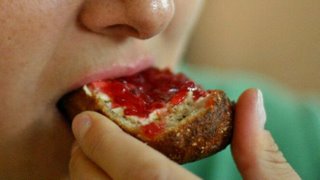Right now it is the end of summer, when you start to look at all of the abundant fruits at the farmer's market and go "Hmm ... all of this will be gone soon. If only there were some way to preserve some so that I can enjoy it's wonderful deliciousness in the winter." But there is! There are several methods of preserving summer fruits and vegetables for the winter. One of them is to make jam.
In addition, Sugar High Friday #22 is all about jam, so I think it's time to try my hand at making jam.
I have only made jam once before. One summer when I was home for college, my friend Karen invited me over to pick berries with her and then make jam. It was completely fun. We picked the berries, and then she told me what to do and I followed her directions and at the end we had these jars of jam. It was like magic to me, who previously had only experienced jam as something that appeared on my sandwiches and didn't think it was something that "real" people just made in their kitchens. I was wrong. I was pricked and sticky and stained but I was also really proud of myself because I was taking home something that I had made myself. That doesn't happen too often when your life is mostly about studying.
Before I attempt to make jam, I thought I'd study up a little first. This isn't a process I think you can just start going down a recipe blindly and be successful. So I turned to where I generally turn in these situations: The American Woman's Cookbook, circa 1945 or so. This book is awesome, because it tells you how to do everything. It's basically a complete course in the food and nutrition part of home economics. It is also the first thing I will grab in a giant emergency because it contains instructions on cooking such things as pigeons and squirrels, including how to dress and skin them and so as long as I find someone who's a good shot, I figure I can survive when society has completely broken down and we're all wild and what-not. In any case, the book also contains a chapter on preserving methods of all types and I read up on the making of jam and learned the following things:
Jam is a preserve made by either mashing up fruit or cooking it with sugar. Jam should feel "soft, tender and jellylike," and look "bright and sparkling." The texture and color should be consistent throughout the mixture. Jam is different from jelly because jam is made from both the juice and the flesh of the fruit, while jelly is made from the juice only (plus some other things).
A portion of the fruit used should be underripe, because underripe fruit contains pectin, which gels the jam and is necessary for it to be good. In order to develop this pectin substance, the fruit should be allowed to cook for a few minutes before the sugar is added. If the fruit itself does not have sufficient juice, add enough water to keep it from burning and cook it in a covered kettle.
When you add the sugar, make sure not to add too much. You should use no more than 3/4 lb. sugar to each pound of fruit. After the sugar has been added to the fruit cook it quickly until the fruit starts to look like jelly. To test, dip a spoon in it. It should hang in sheets from the spoon or should set quickly if dropped on a cool plate. The fruit should now be tender, not thick and tough. Remember that the jam will thicken on cooling so allow for that and don't overcook it. Overcooking will darken the jam.
It's better if you can make a small amount of jam at a time and try to use porcelain or ceramic cooking utensils. Make sure to keep stirring from the bottom using a wooden spoon so that the jam does not burn. Lift the mass from the bottom. Although it is a pain to have to stand and watch for 20-30 minutes while cooking quickly, it will turn out better than if you let it simmer for hours and hours.
Once it's done, seal quickly in a hot, clean jar to keep it safe from mold.
Okay, soon comes my attempt to make the jam. We will see ........

Comments